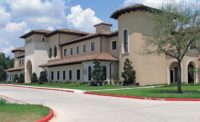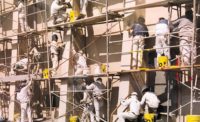Due to fluctuations in global markets and recent trade tariffs, the prices of building materials are steadily rising. The stucco market was recently impacted by new import tariffs imposed on metal lath, a major component of the exterior façade system.
Contractors are facing substantial price increases, long lead times and in some cases spot quotes based on the market price. The benefits of sourcing USA-made materials are evident but non-metallic alternatives may also be an option to combat the increasing prices of metal lath. Fiberglass lath offers the same performance as metal with the added benefit of time and labor savings.
Lath is an important material in the application of stucco. Depending on the substrate, some type of lath is required for installation. Traditionally, expanded metal lath or woven-wire fabric is used but non-metallic alternatives, such as fiberglass, are being introduced into the market. Positioned between the weather resistive barrier and the basecoat in stucco application, lath helps hold the basecoat in place. Self-furring lath has a 3-D profile that creates space between the WRB and the lath. This spacing allows the stucco to be pushed through the lath (keying) for a strong bond and is required for vertical surfaces. Both metal and fiberglass lath can be self-furring.
Safe and Easy
With the growing importance of worker and jobsite safety, lightweight materials are a must-have. In most cases, fiberglass lath is up to four times lighter than traditional metal lath (one roll of fiberglass lath weighs about 30 pounds and is equivalent to 27 sheets of metal lath weighing more than 135 pounds). This lightweight feature makes it easier to ship, handle and maneuver around jobsites.
Unlike most other lath that is sold in sheets, fiberglass lath comes in large rolls. It can easily be carried by hand without team lifting. The flexible material can be unrolled across surfaces for quicker installation and cut to size using a utility knife or scissors without leaving sharp edges. It can also be wrapped around columns and rolled over corners. This saves time during installation because large surfaces can be covered quickly.
Long Term Performance
Exterior façades like stucco can be exposed to moisture from a variety of sources. Weather resistive barriers protect the framework of a building but other components are vulnerable to water damage. Surface moisture from rain or other sources is generally non-damaging unless the stucco is subject to extended exposure. Improper run-off drainage or a leaky spigot, for example, can damage the surface of stucco affecting the appearance and compromising the lath.
Fiberglass lath is protected by an alkali-resistant coating that prevents the lath from deteriorating when exposed to moisture in cement-based applications.
Versatile
Fiberglass lath can be used anywhere that metal lath is used: exterior stucco, cement plaster, manufactured stone and brick façades. Self-furring, open-weave products provide the same continuous reinforcement as metal lath but they must be properly installed for optimal performance and longevity. The standards for installation differ based on the substrate and framing, or manufacturer’s recommendations.
For example, the requirement for the type of fastener and placement is different for metal and fiberglass. All metal and fiberglass lath should be installed to the appropriate ASTM standard.
Fiberglass lath offers the same continuous reinforcement with a stable price and supply. The lightweight construction makes for easy transport and installation that saves contractors time and labor. Fiberglass lath provides long term performance with an alkali-resistant coating that will never rust and has the versatility to be used in exterior stucco, cement plaster, manufactured stone and brick façade applications.
In an ever-changing global economy, the importance of high-quality, alternative materials is growing. It is clear that fiberglass lath is a viable alternative with the added benefit of time and labor savings throughout the installation process.






![WC0422-FEAT-ClarkDietrich-p1FT-CJ-EES[1].jpg WC0422-FEAT-ClarkDietrich-p1FT-CJ-EES[1].jpg](https://www.wconline.com/ext/resources/2022/04/12/WC0422-FEAT-ClarkDietrich-p1FT-CJ-EES%5b1%5d.jpg?height=200&t=1649794590&width=200)

